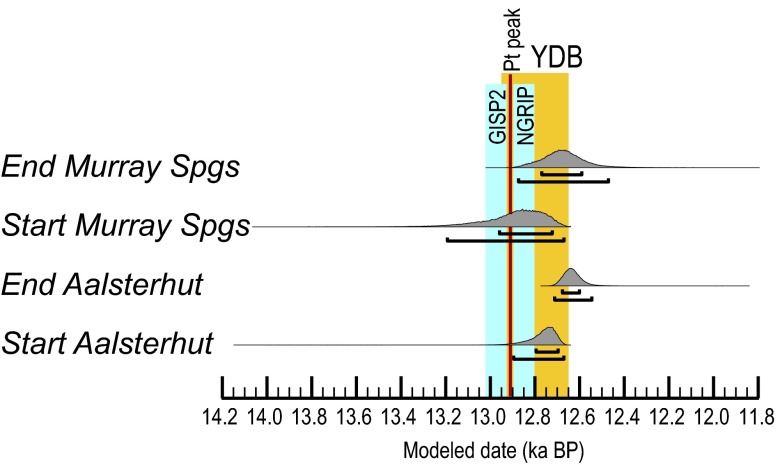Van Hoesel et al. (1) refer to nanodiamonds at the top of the Usselo horizon at Aalsterhut, The Netherlands, having an average age of 10.845 ± 0.015 14C ka (12.70 ± 0.06 cal ka) (1); they found no nanodiamonds outside hat layer. Earlier, nanodiamonds were reported at the top of the Usselo in Lommel, Belgium, ∼30 km southwest of Aalsterhut, acknowledged as the Younger Dryas boundary layer (YDB) [Tian et al. (2)]; those researchers also found no nanodiamonds outside that layer.
Van Hoesel et al. (1) claim that the nanodiamond-rich layer at Aalsterhut postdates the YDB by 200 y. However, that claim is indefensible. Based on eight radiocarbon dates from Murray Springs, averaging 10.89 ± 0.05 14C ka and dates from the Greenland Ice Sheet Project 2 (GISP2) ice core (3), the calibrated YDB age is defined as 12.8 ± 0.15 cal ka [IntCal09 (4)], which overlaps the 12.70 ± 0.060 cal ka age of van Hoesel et al. (1). Nanodiamond-rich layers occur above Clovis-age archaeological materials at multiple North American sites, and this stratigraphic boundary is well-dated to the same time (refs. 3–5 and references therein). The radiocarbon dates from Arlington Canyon were never used to date the YDB because they are systematically older, likely resulting from the burning of large trees [old wood effect (5)].
The calibrated radiocarbon ranges from Aalsterhut and Murray Springs are virtually indistinguishable (Fig. 1). The age estimate for each is shown as probability distributions, defining the beginning and end of deposition (modeled as boundaries in OxCal 4.2). The Aalsterhut distribution comes from 14 dates (1), and Murray Springs is derived from eight radiocarbon dates (refs. 3–5 and references therein). The age distributions for these two sites are comparable and fall within the estimated YDB age range. Therefore, all dates for the nanodiamond-rich layers found at those two key sites are consistent with the age of the cataclysmic YDB impact event, now clearly defined at the beginning of the Younger Dryas cooling episode in the Greenland ice sheet (6).
Fig. 1.
Aalsterhut calibrated age range estimates from ref. 1. Murray Springs from refs. 3 and 5. Pt peak in GISP2 from ref. 6, shown relative to YD onset from the GISP2 and North Greenland Ice Core Project (NGRIP) (turquoise). YDB in yellow.
Footnotes
The authors declare no conflict of interest.
References
- 1.van Hoesel A, Hoek WZ, van der Plicht J, Pennock GM, Drury MR. Cosmic impact or natural fires at the Allerød–Younger Dryas boundary: A matter of dating and calibration. Proc Natl Acad Sci USA. 2013;110:E3896. doi: 10.1073/pnas.1311174110. [DOI] [PMC free article] [PubMed] [Google Scholar]
- 2. Tian H, Schryvers D, Claeys P (2011) Nanodiamonds do not provide unique evidence for a Younger Dryas impact. Proc Natl Acad Sci USA 108(1):40–44. [DOI] [PMC free article] [PubMed]
- 3.Firestone RB, et al. Evidence for an extraterrestrial impact 12,900 years ago that contributed to the megafaunal extinctions and the Younger Dryas cooling. Proc Natl Acad Sci USA. 2007;104(41):16016–16021. doi: 10.1073/pnas.0706977104. [DOI] [PMC free article] [PubMed] [Google Scholar]
- 4.Wittke JH, et al. Evidence for deposition of 10 million tonnes of impact spherules across four continents 12,800 y ago. Proc Natl Acad Sci USA. 2013;110(23):E2088–E2097. doi: 10.1073/pnas.1301760110. [DOI] [PMC free article] [PubMed] [Google Scholar]
- 5.Kennett DJ, et al. Wildfire and abrupt ecosystem disruption on California’s Northern Channel Islands at the Ållerød–Younger Dryas boundary (13.0–12.9 ka) Quat Sci Rev. 2008;27(27–28):2530–2545. [Google Scholar]
- 6.Petaev MI, Huang S, Jacobsen SB, Zindler A. Large Pt anomaly in the Greenland ice core points to a cataclysm at the onset of Younger Dryas. Proc Natl Acad Sci USA. 2013;110(32):12917–12920. doi: 10.1073/pnas.1303924110. [DOI] [PMC free article] [PubMed] [Google Scholar]



